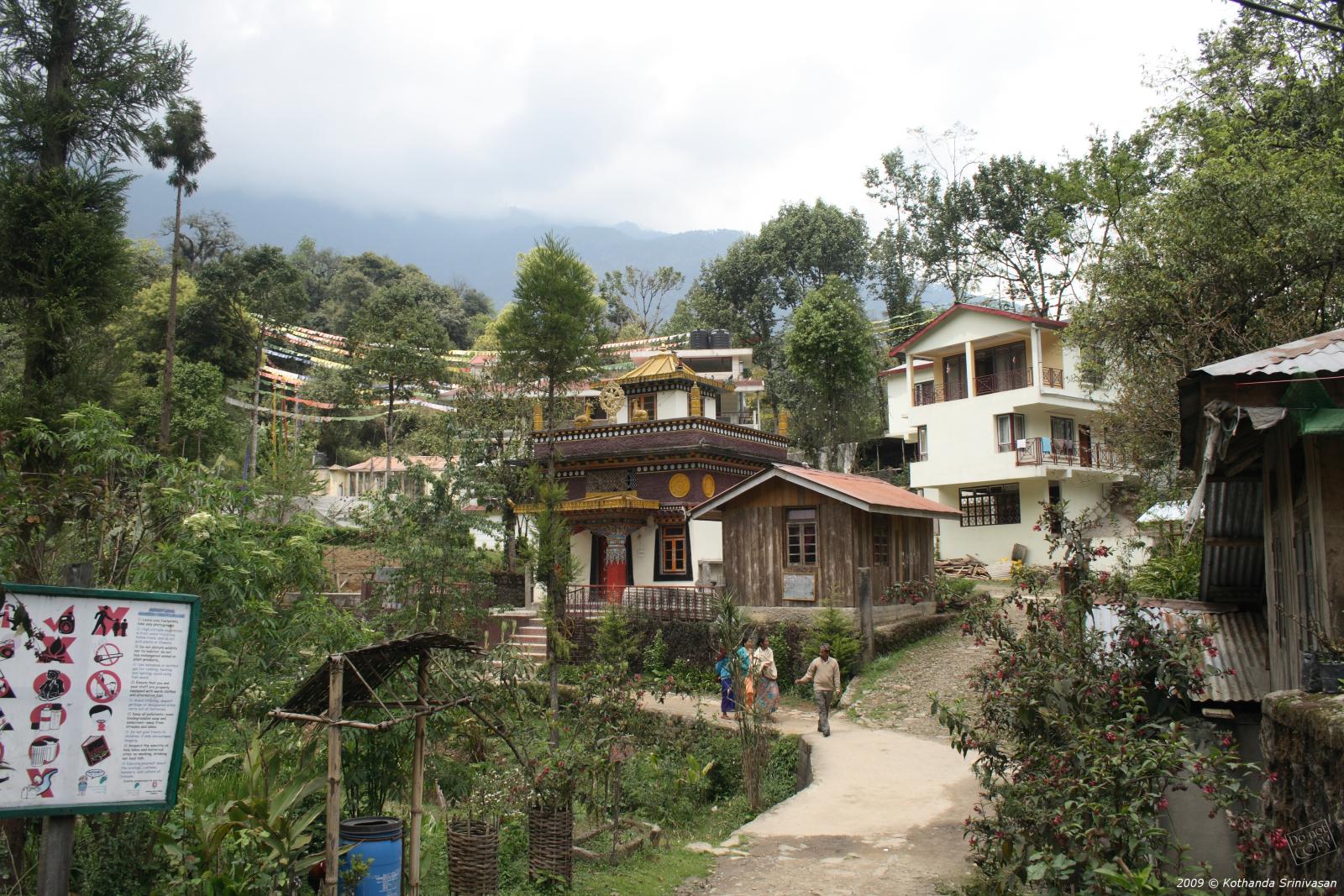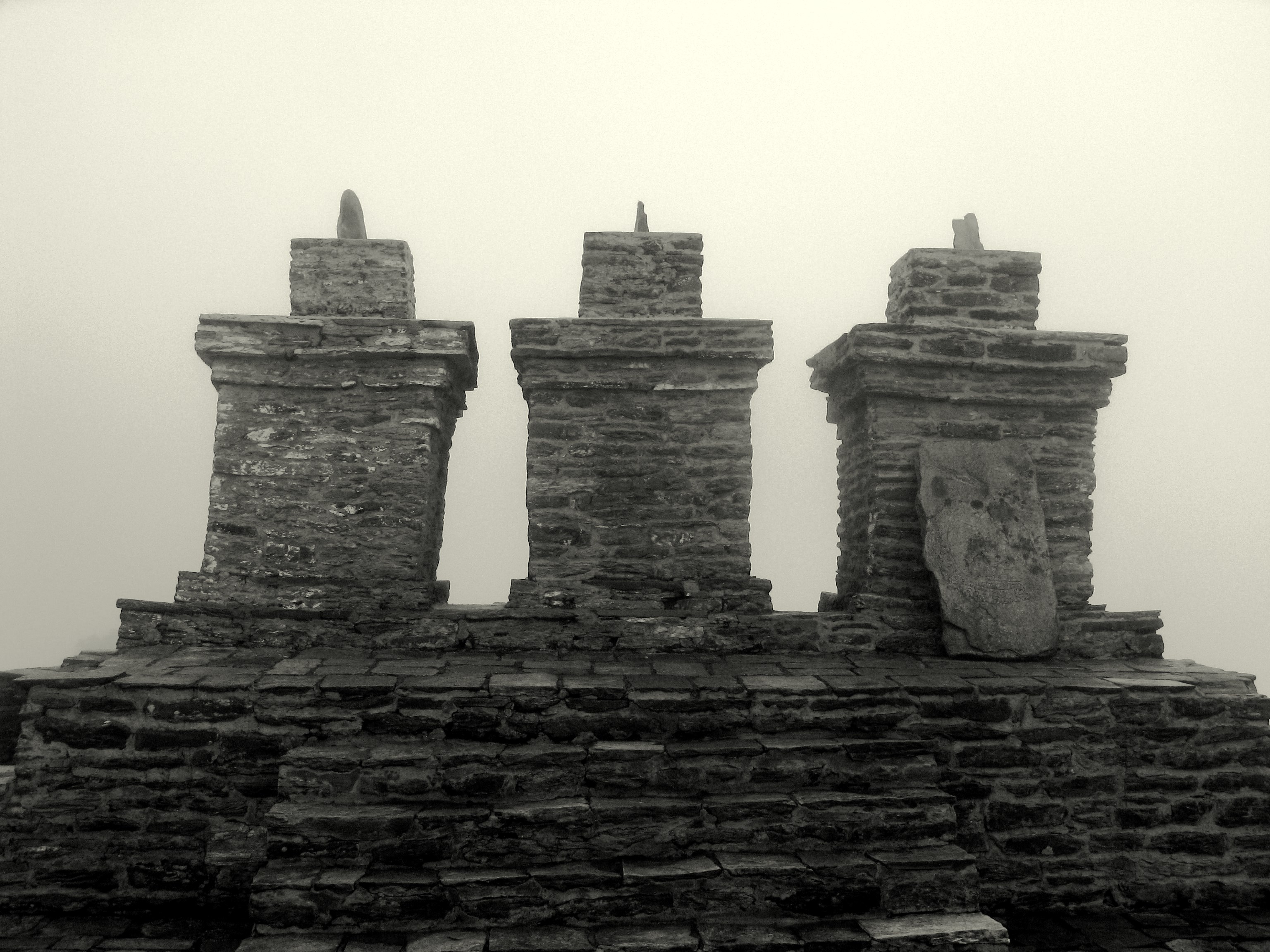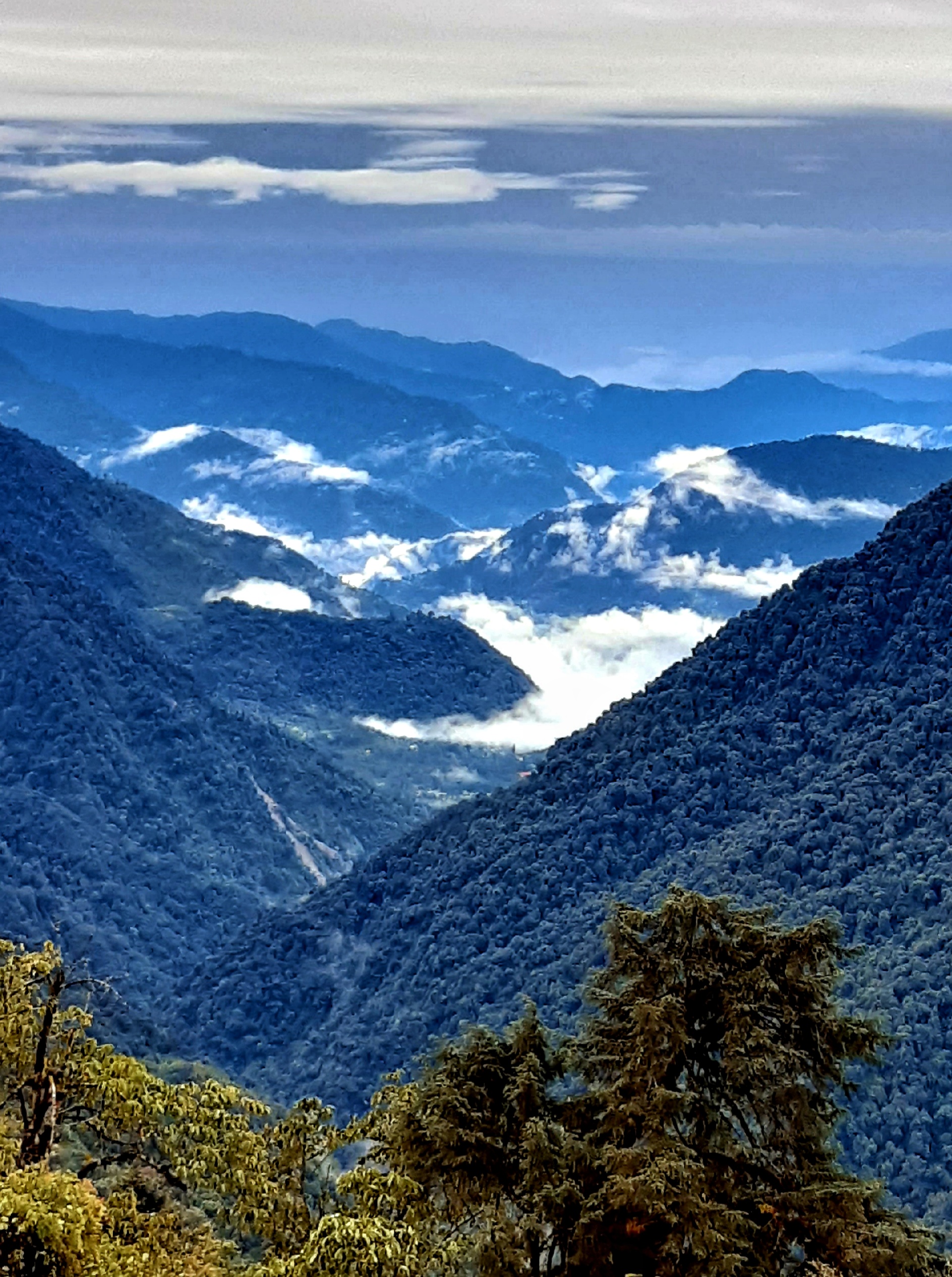|
Yuksom
Yuksom is a historical town in Geyzing subdivision of West Sikkim district in the Northeast Indian state of Sikkim. It was the first capital of Kingdom of Sikkim established in 1642 AD by Phuntsog Namgyal who was the first Chogyal (temporal and religious king) of Sikkim. The coronation site of the first monarch of Sikkim is known as the "Throne of Norbugang". Yuksom is where there is the Norbugang Chorten near the Norbugang throne, the place Namgyal was crowned and several monasteries and a lake. The dynastic rule of the Chogyals lasted for 333 years. The Chogyal established the first monastery at Yuksom in Sikkim known as the Dubdi Monastery in 1701, which is part of Buddhist religious pilgrimage circuit involving the Norbugang Chorten, Pemayangtse Monastery, the Rabdentse ruins, the Sanga Choeling Monastery, the Khecheopalri Lake, and the Tashiding Monastery. For the Bhutia community of Sikkim, Yuksom has special religious and cultural significance. It has a number of famous B ... [...More Info...] [...Related Items...] OR: [Wikipedia] [Google] [Baidu] |
Dubdi Monastery
Dubdi Monastery, occasionally called Yuksom Monastery, is a Buddhist monastery of the Nyingma sect of Tibetan Buddhism near Yuksom, in the Geyzing subdivision of West Sikkim district, in eastern India. The Chogyar Namgyal established the first monastery known as the Dubdi Monastery in 1701, at Yuksom in Sikkim, which is part of Buddhist religious pilgrimage circuit involving the Norbugang Chorten, Pemayangtse Monastery, the Rabdentse ruins, the Sanga Choeling Monastery, the Khecheopalri Lake and the Tashiding Monastery. Established in 1701, it is professed to be the oldest monastery in Sikkim and is located on the top of a hill which is about an hour's walk () from Yuksom. It was also known as the Hermit's Cell after its ascetic founder Lhatsun Namkha Jigme, who along with two other lamas from Tibet met at Norbugang near Yuksom and crowned Phuntsog Namgyal as the first King or Chogyal of Sikkim at Norbugang Yuksom in 1642. The literal meaning of 'Dubdi' in local language ... [...More Info...] [...Related Items...] OR: [Wikipedia] [Google] [Baidu] |
Norbugang Chorten
The Norbugang Chorten is a stupa situated in the Geyzing subdivision of West Sikkim district in the Indian State of Sikkim. It was erected following the crowning of the first Chogyal of Sikkim in 1642 at Narbugong Coronation Throne near Yuksom. A holy lake known as Kuthok Lake, a serene lake, is also linked to the historicity of the place. The Chorten was the place where Lama Lhutsun Chempo created the time capsule by burying all the gifts to mark the occasion. The Norbugang Chorten and the Norbugang throne are visited as part of Buddhist religious pilgrimage circuit involving the Dubdi Monastery, Pemayangtse Monastery, the Rabdentse ruins, the Sanga Choeling Monastery, the Khecheopalri Lake, and the Tashiding Monastery. History Norbugang Chorten was established during a consecration ceremony that was held by three learned Lamas headed by Lhatsun Chempo, crowning the first Chogyal of Sikkim. Lhatsun Chempo had suffixed his own surname of 'Namgye' to Phunshog who was crowned th ... [...More Info...] [...Related Items...] OR: [Wikipedia] [Google] [Baidu] |
Khecheopalri Lake
Khecheopalri Lake, originally known as Kha-Chot-Palri (meaning the heaven of Padmasambhava), is a lake located near Khecheopalri village, west of Gangtok in the West Sikkim district of the Northeastern Indian state of Sikkim. Located to the northwest of Pelling town, the lake is sacred for both Buddhists and Hindus, and is believed to be a wish fulfilling lake. The local name for the lake is ''Sho Dzo Sho'', which means "Oh Lady, Sit Here". The popularly known name of the lake, considering its location is Khecheopalri Lake, ensconced in the midst of the Khechoedpaldri hill, which is also considered a sacred hill. The lake is an integral part of the much revered valley of "Demazong" meaning valley of rice. This landscape is also known as a land of hidden treasures blessed by Guru Padmasambhava. The Khecheopalri Lake is also part of Buddhist religious pilgrimage circuit involving the Yuksom, the Dubdi Monastery in Yuksom, Pemayangtse Monastery, the Rabdentse ruins, the Sang ... [...More Info...] [...Related Items...] OR: [Wikipedia] [Google] [Baidu] |
Sikkim
Sikkim (; ) is a state in Northeastern India. It borders the Tibet Autonomous Region of China in the north and northeast, Bhutan in the east, Province No. 1 of Nepal in the west and West Bengal in the south. Sikkim is also close to the Siliguri Corridor, which borders Bangladesh. Sikkim is the least populous and second smallest among the Indian states. Situated in the Eastern Himalaya, Sikkim is notable for its biodiversity, including alpine and subtropical climates, as well as being a host to Kangchenjunga, the highest peak in India and third highest on Earth. Sikkim's capital and largest city is Gangtok. Almost 35% of the state is covered by Khangchendzonga National Park – a UNESCO World Heritage Site. The Kingdom of Sikkim was founded by the Namgyal dynasty in the 17th century. It was ruled by Buddhist priest-kings known as the Chogyal. It became a princely state of British India in 1890. Following Indian independence, Sikkim continued its protectorate stat ... [...More Info...] [...Related Items...] OR: [Wikipedia] [Google] [Baidu] |
Rabdentse
Rabdentse was the second capital of the former Kingdom of Sikkim from 1670 to 1814. The capital city was destroyed by the invading Gurkha army and only the ruins of the palace and the chortens are seen here now. However, the ruins of this city are seen close to Pelling and in West Sikkim district in the Northeastern Indian state of present-day Sikkim; Pemayangtse Monastery is one of the oldest monasteries in Sikkim which is close to the ruins. From the vantage point of this former capital, superb views of the Khanchendzonga ranges can be witnessed. This monument has been declared as of national importance by the Archaeological Survey of India. It was first established in 1670 by the 2nd Chogyal Tensung Namgyal son of the 1st Chogyal Phuntsog Namgyal by shifting from the first capital of Yuksom that was consecrated in 1642. The Rabdentse ruins are part of Buddhist religious pilgrimage circuit starting with the first monastery at Yuksom known as the Dubdi Monastery, followed ... [...More Info...] [...Related Items...] OR: [Wikipedia] [Google] [Baidu] |
Chogyal
The Chogyal ("Dharma Kings", ) were the monarchs of the former Kingdom of Sikkim, which belonged to the Namgyal dynasty. The Chogyal was the absolute monarch of Sikkim from 1642 to 1975, when the monarchy was abolished and the Sikkimese people voted in a referendum to make Sikkim the 22nd state of India. History From 1642 to 1975, Sikkim was ruled by the Namgyal Monarchy (also called the Chogyal Monarchy), founded by Phuntsog Namgyal, the fifth-generation descendant of Guru Tashi, a prince of the Minyak House who came to Sikkim from the Kham province of Tibet. Chogyal means 'righteous ruler', and was the title conferred upon Sikkim's Buddhist kings during the reign of the Namgyal Monarchy. The reign of the Chogyal was foretold by the patron saint of Sikkim, Guru Rinpoche. The 8th-century saint had predicted the rule of the kings when he arrived in the state. In 1642, Phuntsog Namgyal was crowned as Sikkim's first Chogyal in Yuksom. The crowning of the king was a g ... [...More Info...] [...Related Items...] OR: [Wikipedia] [Google] [Baidu] |
West Sikkim
Gyalshing District or Geyzing District is a district of the Indian state of Sikkim. Its headquarter is Geyzing, also known as Gyalshing. The district is a favourite with trekkers due to the high elevations. Other important towns include Pelling and Yuksom. Local people also call it as ''Pallo-Sikkim'' and ''Sano-Sikkim'' commonly. History West Sikkim is the site of the ancient state capital Yuksom. West Sikkim It served as Sikkim's capital beginning in 1642 for almost 50 years until it was shifted to Rabdentse. The district was under the occupation of the Nepalese for 30 years in the eighteenth and nineteenth centuries. After Anglo-Nepalese War (1814–16), the district was returned to Sikkim. Geography West Sikkim covers an area of . Attractions include the Khecheopalri Lake, where, according to legend, not a leaf is allowed to fall on the surface of the lake and the Dubdi Monastery, the first monastery of the state. Assembly constituencies The district was previously divid ... [...More Info...] [...Related Items...] OR: [Wikipedia] [Google] [Baidu] |
Pemayangtse Monastery
The Pemayangtse Monastery is a Buddhism, Buddhist monastery in Pemayangtse, near Pelling in the northeastern Indian state of Sikkim, located 110 km west of Gangtok. Planned, designed and founded by Lama Lhatsun Chempo in 1647, it is one of the oldest and premier monasteries of Sikkim, also the most famous in Sikkim. Originally started as a small Lhakhang, it was subsequently enlarged during the reign of the third Chogyal Chakdor Namgyal and Khenchen Rolpai Dorjee in the year 1705 and consecrated by the third Lhatsun Chenpo Dzogchen Jigme Pawo in the year 1710 C.E. The monastery follows the Nyingma Order of Tibetan Buddhism and controls all other monasteries of that Order in Sikkim. The monks of this monastery are normally chosen from the Bhutias of Sikkim. The monastery was built for "pure monks" (''ta-tshang'') meaning "monks of pure lineage", celibate and without any physical abnormality. This practice is still retained. Only the monks of Pemayangtse Monastery are entit ... [...More Info...] [...Related Items...] OR: [Wikipedia] [Google] [Baidu] |
Sanga Choeling Monastery
The Sanga Choeling Monastery, also spelt Sange Choeling Monastery (, THL ''Sangngak Chö Ling''), established in the 17th century by Lama Lhatsün Chempo, is one of the oldest monasteries in the Northeast Indian state of Sikkim. The literal meaning of Sanga Choeling is "Island of the Guhyamantra teachings", where ''gling'' means a vihara and "secret Mantra teachings" is a synonym for "Vajrayana Buddhism". The monastery is located on a ridge top above Pelling at a distance of from Pemayangtse Monastery and is accessed by walking the steep hilly track of , which traverses through rich forest cover. Pilgrimage to Sanga Choeling Monastery is undertaken by many Buddhist devotees as part of a religious and heritage circuit encompassing Pemayangtse Monastery, Rabdentse ruins, Khecheopalri Lake, Norbugang Chorten, Dubdi Monastery, Yuksom and Tashiding Monastery. Architecture Sanga Choeling Monastery, built in 1697, is also known as the place of secret spells. It has clay statues d ... [...More Info...] [...Related Items...] OR: [Wikipedia] [Google] [Baidu] |
Tashiding Monastery
Tashiding Monastery is a Buddhist monastery of the Nyingma sect of Tibetan Buddhism in Western Sikkim, northeastern India, which is the most sacred and holiest monasteries in Sikkim. It is described as the "Heart of Sikkim/Denzong", citing to its importance of religious sacredness. It is located on top of the hill rising between the Rathong chu and the Rangeet River, from Gyalshing and to the south east of Yuksam. The annual festival of Bumchu, meaning ~Holy water~ takes place on the 14th and 15th of the 1st month of Tibetan lunar calendar, often around the months of February and March. The festival is believed to predict the upcoming forecasts and events for Sikkim in the coming year. Undoubtedly, one of the most important and holiest festivals for all the Buddhists in Sikkim and around, it also provides for a perfect platform for all those Non-Buddhists who seek a deeper insight into Buddhism and its religious customs, beliefs and rituals. History of the Festival- Somewhere ... [...More Info...] [...Related Items...] OR: [Wikipedia] [Google] [Baidu] |
West Sikkim District
Gyalshing District or Geyzing District is a district of the Indian state of Sikkim. Its headquarter is Geyzing, also known as Gyalshing. The district is a favourite with trekkers due to the high elevations. Other important towns include Pelling and Yuksom. Local people also call it as ''Pallo-Sikkim'' and ''Sano-Sikkim'' commonly. History West Sikkim is the site of the ancient state capital Yuksom. West Sikkim It served as Sikkim's capital beginning in 1642 for almost 50 years until it was shifted to Rabdentse. The district was under the occupation of the Nepalese for 30 years in the eighteenth and nineteenth centuries. After Anglo-Nepalese War (1814–16), the district was returned to Sikkim. Geography West Sikkim covers an area of . Attractions include the Khecheopalri Lake, where, according to legend, not a leaf is allowed to fall on the surface of the lake and the Dubdi Monastery, the first monastery of the state. Assembly constituencies The district was previously divid ... [...More Info...] [...Related Items...] OR: [Wikipedia] [Google] [Baidu] |
Phuntsog Namgyal
Phuntsog Namgyal ( Sikkimese: ; Wylie: ''phun tshog rnam rgyal'') (1604–1670) was the first chogyal (monarch) of Sikkim, now an Indian state. He consecrated in 1642 at the age of 38. Phuntsog was a fifth generation descendant of Khye Bumsa, a 13th-century prince from the Mi-nyak House in Kham in Eastern Tibet. According to legend, Guru Rinpoche, a 9th-century Buddhist saint had foretold the event that a Phuntsog from the east would be the next chogyal of Sikkim. In 1642, three lamas, from the north, west, and south went in search for the chosen person. Near present-day Gangtok, they found a man churning milk. He offered them some refreshments and gave them shelter. So impressed were they by his deeds that they realised that he was a chosen one and immediately crowned him king. The crowning took place Norbughang near Yuksom on a stone slab in a pine covered hill, and he was anointed by sprinkling water from a sacred urn. Phuntsog, along with the lamas, then converted the ... [...More Info...] [...Related Items...] OR: [Wikipedia] [Google] [Baidu] |






